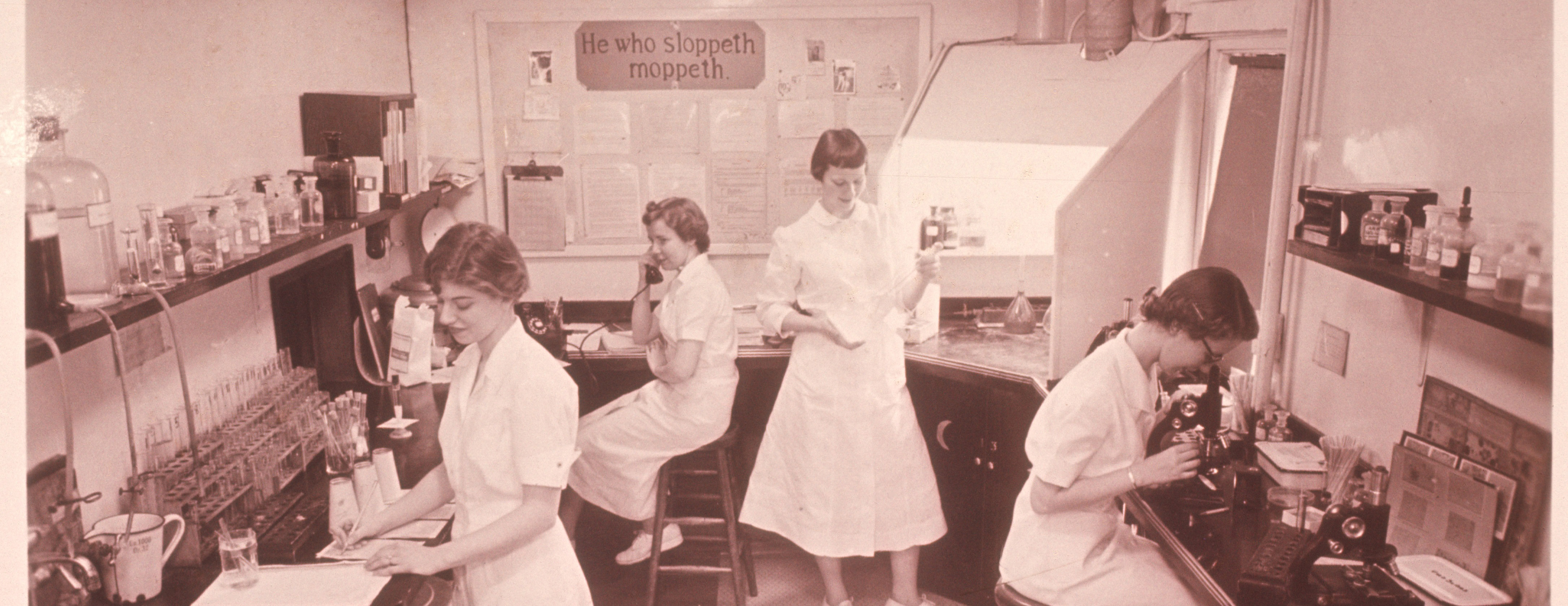The MLS Program at the University of Minnesota has a rich history. Click the accordion panels below to explore highlights from each decade.
History by Decade
1920's

- University of Minnesota bulletin offering courses in Medical Technology for Clinical and Laboratory Technicians published on March 10, 1922. It contained the following announcement:
- “The demand for clinical and laboratory technicians trained in the principles and techniques of the medical sciences is increasing. The technician so trained is an aide to the physician, the surgeon, the medical specialist, the group clinic, the hospital, or the teaching and research laboratory. The vocation is one that offers satisfactory objectives, a large measure of usefulness, and fair compensation.”
- Four sequences were offered at that time to the student in the third and fourth years of the Course in the Medical School: a) sequence leading to service as a clinical technician; b) sequence leading to technical service in pathology, neuropathology, and gynepathology; c) sequence leading to technical service in bacteriology and serology; and d) sequence leading to technical service in anatomy or neurology.
- Dr. Richard Olding Beard served as Director of the Course in Medical Technology.
- First baccalaureate degree medical technology program in the U.S.
- First three students graduated from the program 1923
- In 1925, Dr. William O’Brien becomes director when Dr. Beard retires
- (Photo shows Dr. O’Brien sitting at desk in University Hospital Clinical Laboratory)
- Between 1922-1926, the program had 13 graduates
- The University Hospital Report from 1927-28 indicated that 24,869 tests had been carried out during that academic year, and that only ten different chemistry determinations were performed by the laboratory.
- The 1929 Medical Technology Practical Schedule
| General Laboratory (Hematology, Chemistry, and Bacteriology) | 4 months |
|---|---|
| Tissues | 2 months |
| Metabolism and Electrocardiography | 1 month |
| Serology | 1 month |
| X-ray | 4 months |
1930's
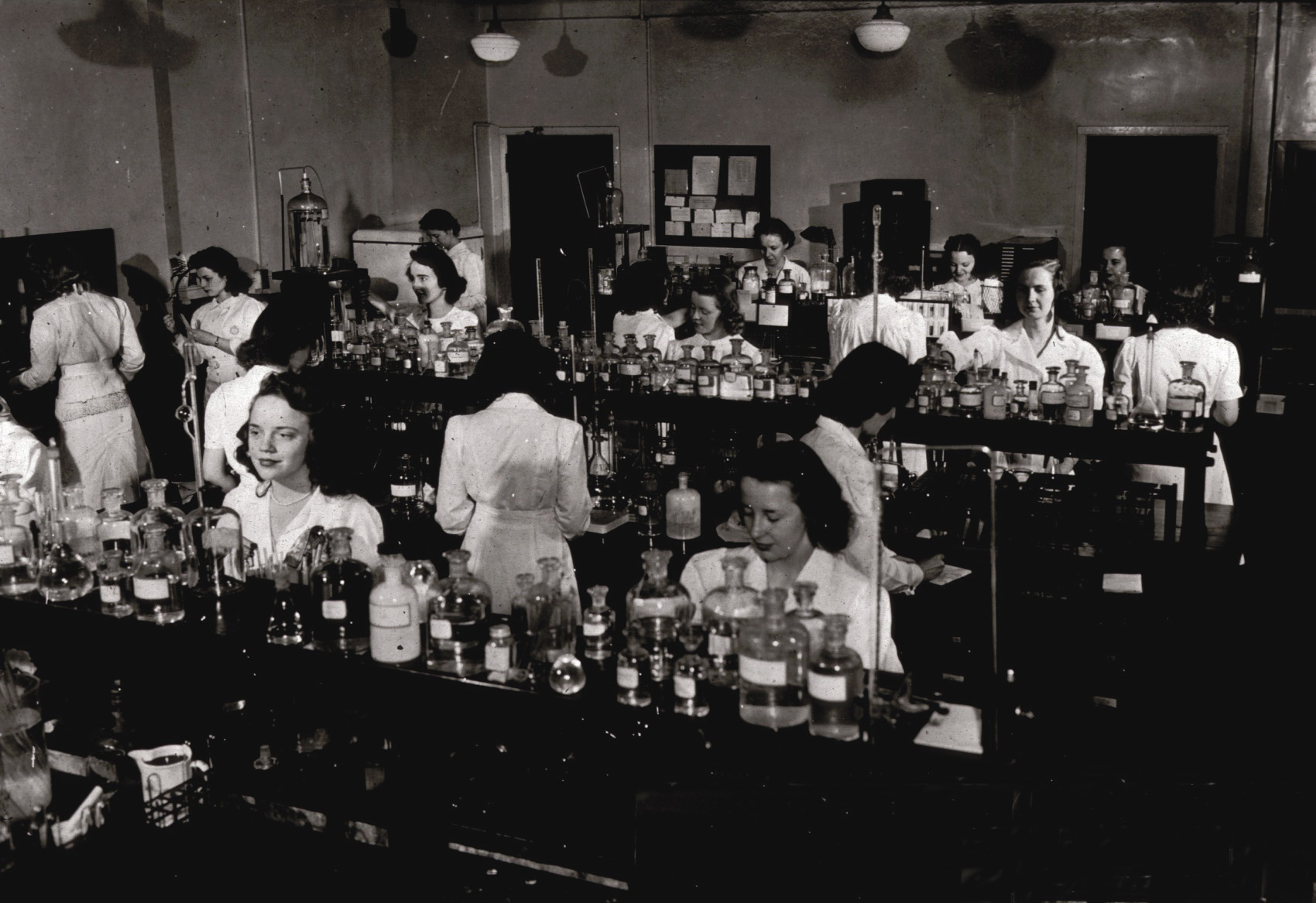
- In 1934, a regular system of submitting grades to the Registrar’s Office was started.
Between 1927-1936, there were 201 graduates. The need for well-prepared medical technologists was growing, and the University of Minnesota’s program was growing to meet that need.
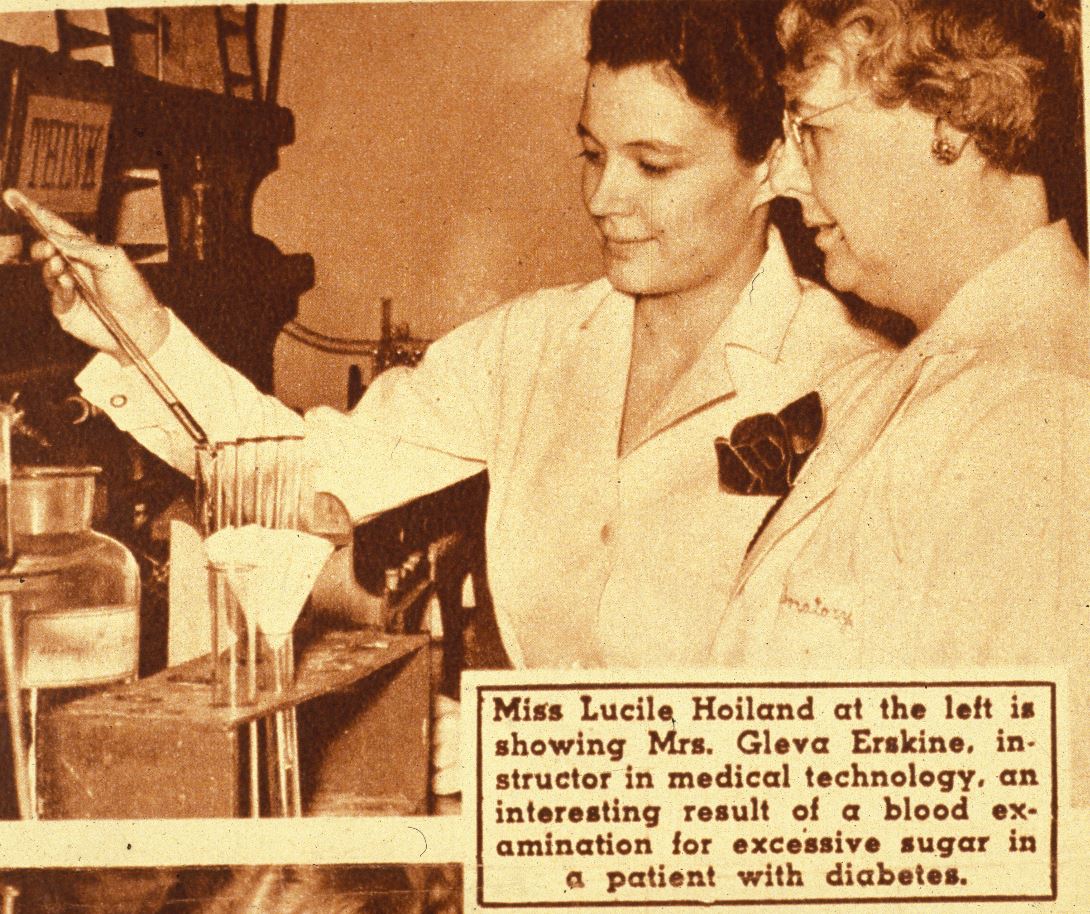
- In 1936, Mrs. Gleva Blain Erskine, the program’s first full-time instructor,was appointed, and a budget of $600 a year to be used for teaching purposes was allocated to the program. The budget provided the program with sufficient funds to provide “for mimeographed exams, a supply of pipettes and counting chambers with which students could practice, and textbooks for reference in the laboratory.”
- In September 1938, the curriculum was changed again, such that X-ray and radiology were no longer required for graduation after July 1, 1939
| General Laboratory (Hematology, Chemistry, and Bacteriology) | 3.5 months |
|---|---|
| Bacteriology | 2 months |
| Blood Chemistry | 2 months |
| Tissues | 2 months |
| Metabolism and Electrocardiography | 1.5 months |
| Serology | 1 month |
| Total | 12 months |
- In 1939, Dr. Gerald T. .Evans appointed as Director of the Course in Medical Technology
1940's
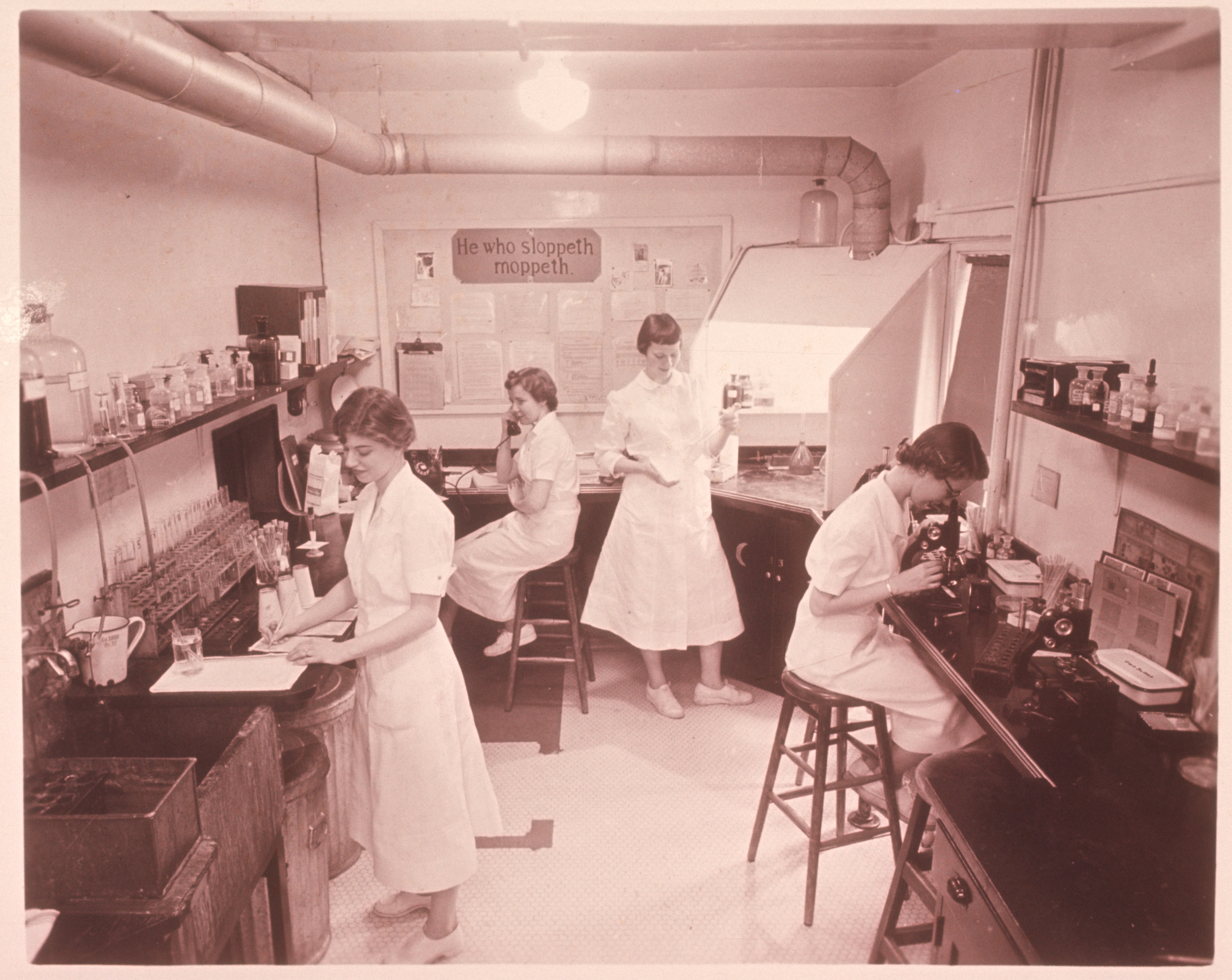
- By the early 1940’s, blood banking was added to the curriculum. Blood banking questions are asked on the registry exam (PDF) by May, 1942.
- 1944 - Alpha Delta Theta professional fraternity of Medical Technology founded at the University of Minnesota on February 1, 1944 to unite all women entering into or engaging in the field of medical technology to promote social and intellectual fellowship among its members and to raise the prestige of medical technologists by inspiring the members to greater group and individual effort. The colors of Alpha Delta Theta were described as the green of medicine and the gold of science. The fraternity flower was the daffodil.
- Between 1937-1946, there were 536 graduates. The program was continuing to grow.
The class of 1947 had 78 graduates, the largest number of graduates in one year in the program’s history.
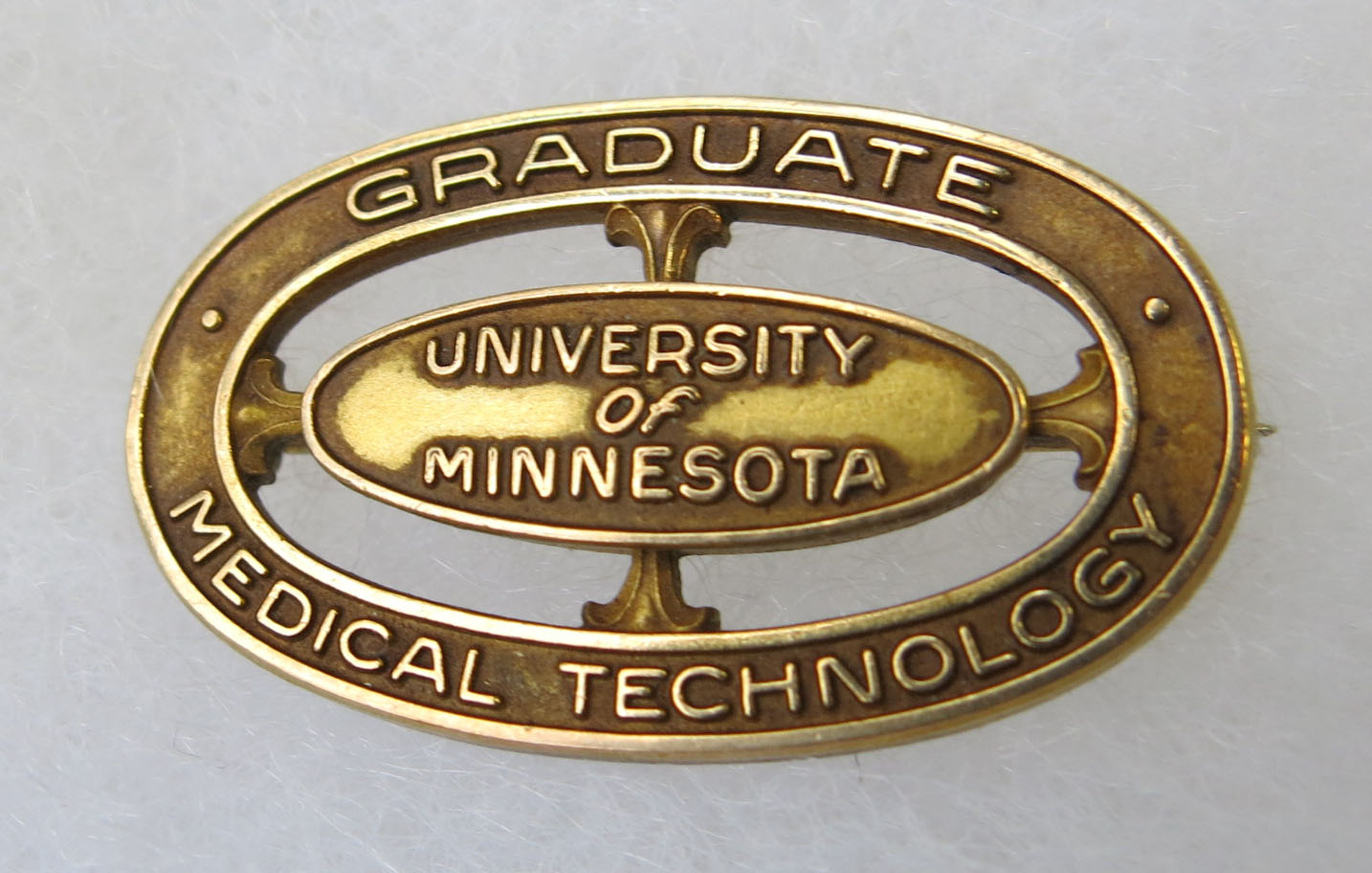
UMN MT pin for graduates 1949
1950's
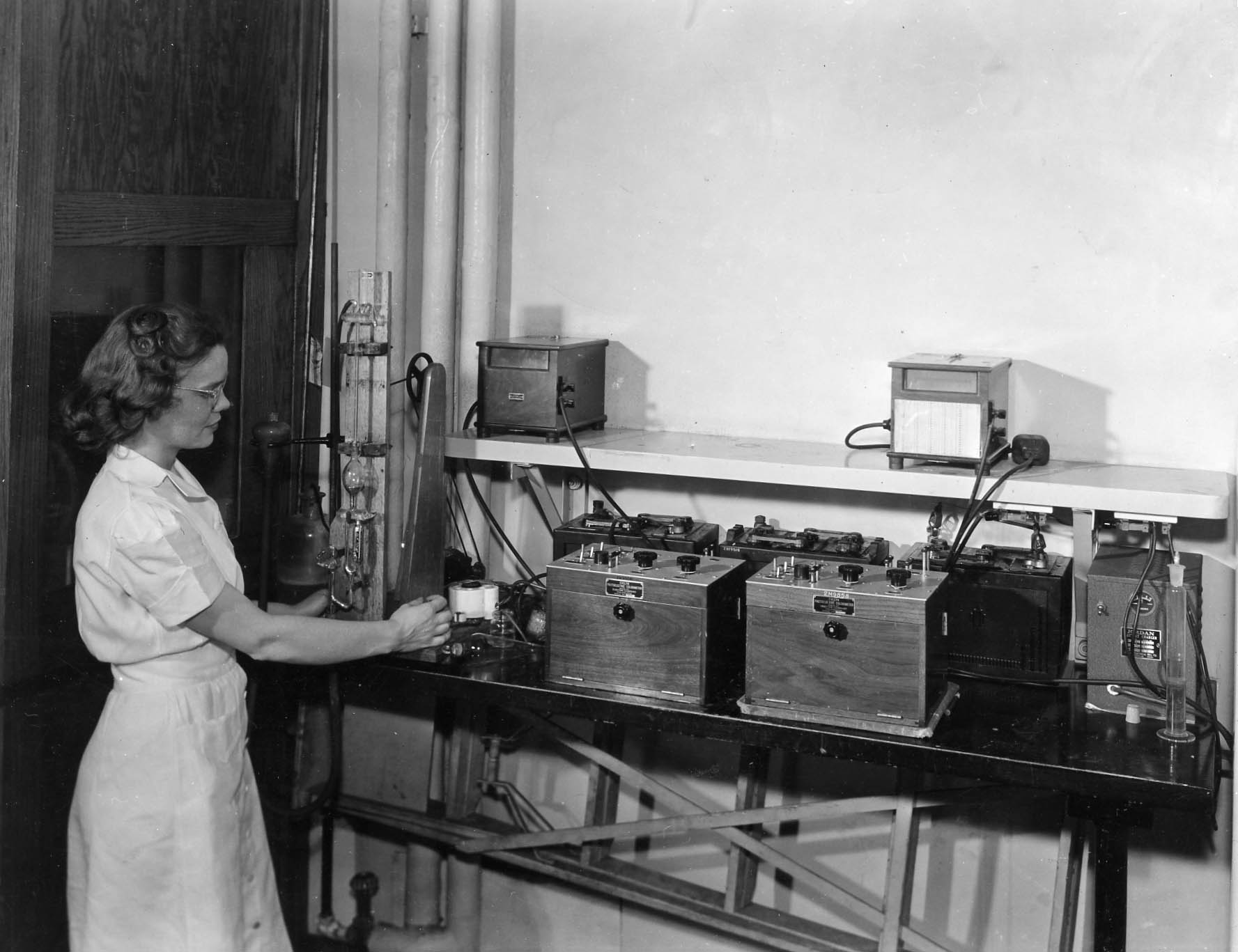
- The cost to attend the Annual Spring Banquet in 1951 is $1.75.
- In response to a need expressed by the Minnesota Medical Association for more trained laboratory workers, in 1953, the Medical Technology Program established a program for supportive level laboratory personnel, the Clinical Laboratory Assistants Program. This program was the first of its kind in the country. (Entertainment at the Spring banquet that year included “a Hungarian and a Scottish dance, a piano solo, and the Med Tech chorus.” Found in the April 1953 Tech’s Talk)
- In 1954, the University of Minnesota Hospital laboratories and the Medical Technology Program offices are moved to the second floor of the new Mayo Building on campus
- Enrollments began to decline. Between 1947-1956, there were only 360 graduates.
- The Medical Technology Program gets its first scholarship for University of Minnesota Medical Technology students, the William A. O’Brien Scholarship. The recipient was announced at the Annual Spring Banquet in 1956.
- Medical Technology Program faculty Esther Freier and Verna Rausch author one of the first articles dealing with quality control in the clinical laboratory (Quality Control in Clinical Chemistry American Journal of Medical Technology 24(4):195-207. 1958)
- In 1959, the University of Minnesota became the first institution to implement a master’s level program in medical technology
1960's
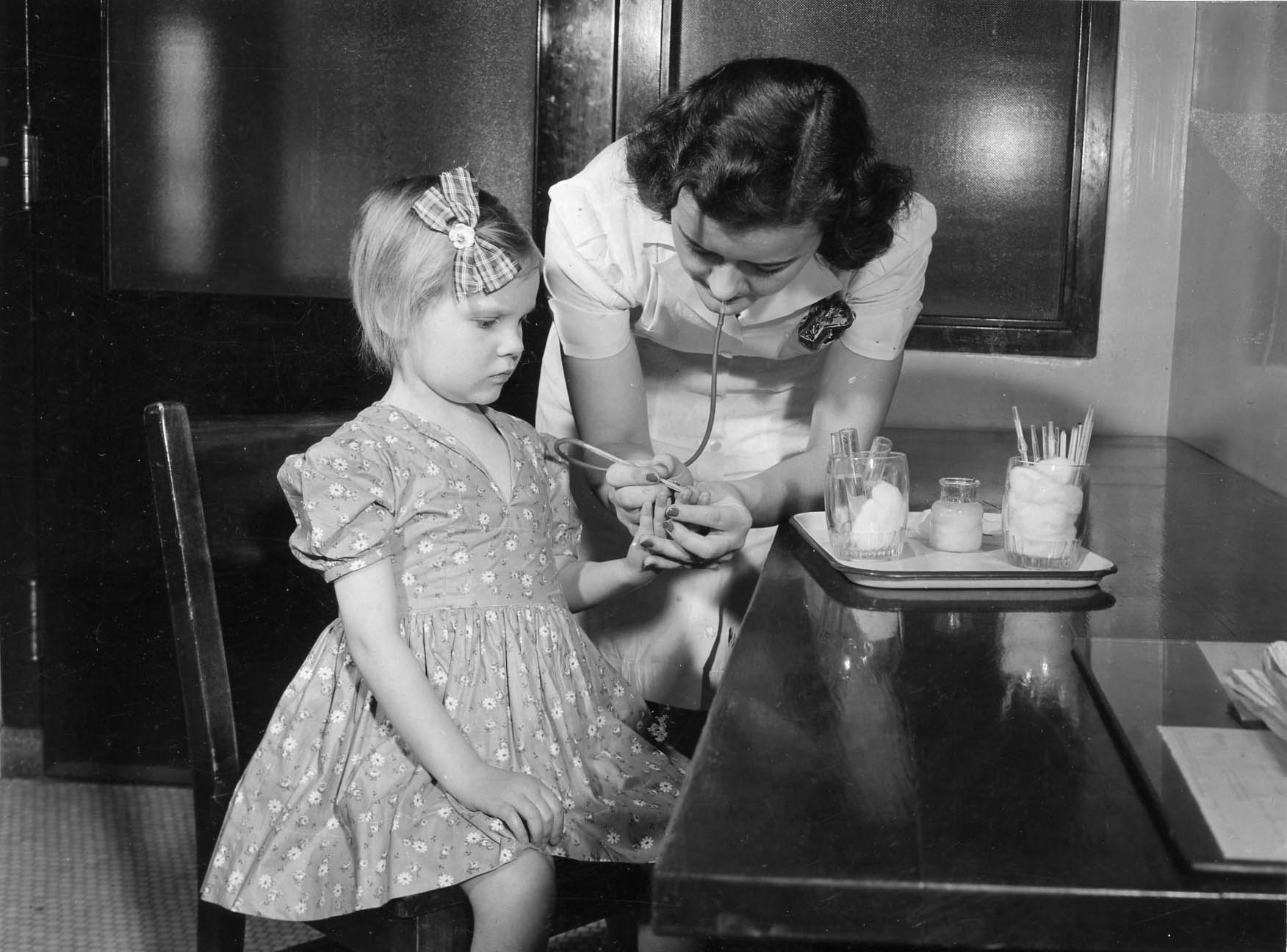
- In 1961, the cost to attend the Spring Banquet is $2.75.
- In 1962, starting salaries for medical technology graduates ranged between $400-433 per month.
- In 1963, the University of Minnesota’s Medical Technology Program was featured in an article in Mademoiselle magazine (PDF).
- In 1964, the cost of resident tuition was $110 per quarter. However the Medical Technology Program was able to award two scholarships of $75 to two students.
- In 1967, the Medical Technology Program made the switch from students spending a full year in hospital laboratories, to spending most of their instruction in student laboratories.
- On March 30, 1966, Ruth Hovde (PDF), Director of the Division of Medical Technology at UMN testified before the Committee on Interstate and Foreign Commerce of the US House of Representatives regarding the need for funding medical technology programs and scholarships for MT students.
- The increased time in student laboratories, and a focus on graduate education also prompted the move of the Medical Laboratory Assistants Program from the University of MInnesota to the St. Paul Area Technical Vocational Institute (TVI). Today, TVI is St. Paul College, and the Medical Laboratory Assistants Program is the Medical Laboratory Technician Program. Under guidance of Verna Rausch, the UMN originated the 2 + 2 educational model: two years of pre-professional courses and two years of the professional program
1970's
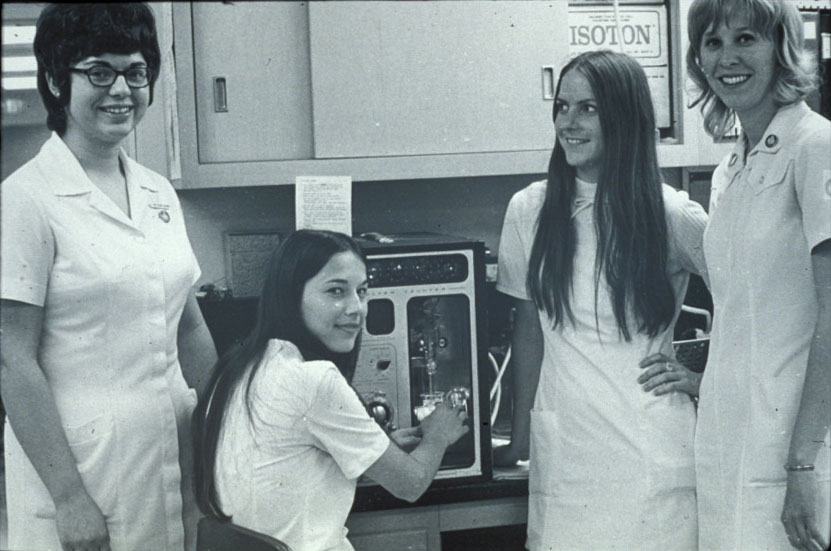
- In 1972, the cost of dinner at the Alumni Banquet (formerly called the Annual Spring Banquet) has gone up to $6.00
- Program turns 50 years old. JoAnn Keller, President of the Class of 1973, secretly invites Marjorie Knowlton, one of the first three graduates of the Medical Technology Program to hand out diplomas to the 50th graduating class.
- In 1975, the medical technology curriculum introduced a course in laboratory administration.
- In 1977, Medical Technology faculty Esther Freier and Verna Rausch receive the Professional Achievement Lectureship from American Society of Medical Technology for distinguished contributions to the practice of medical technology
- In June, 1978, the 2000th student received their baccalaureate degree in Medical Technology Program from the University of Minnesota’s MT Program.
1980's
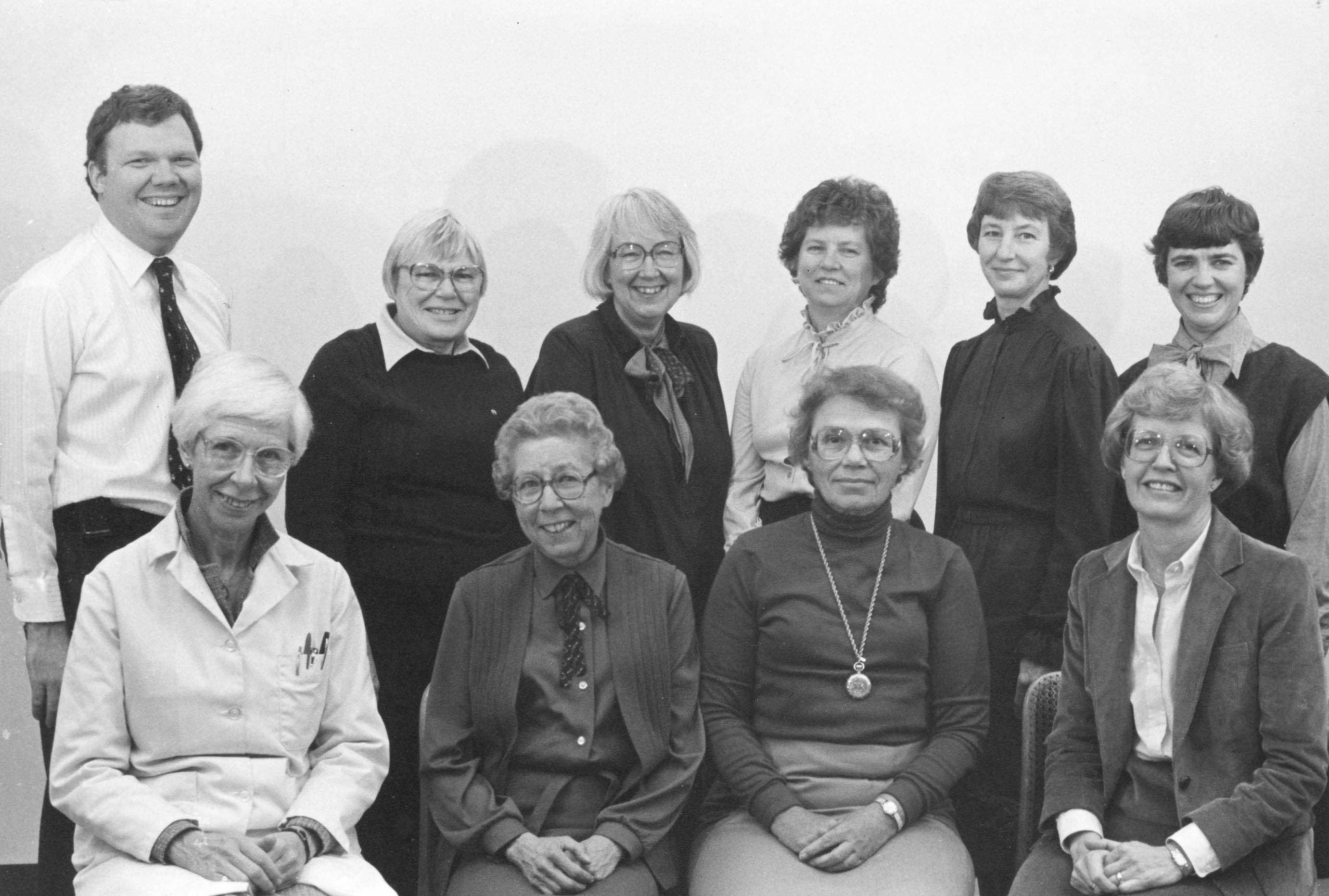
- In 1981, the cost to attend the Alumni Banquet is up to $15.00
- In June, 1981, Ruth Hovde, Director of the Division of Medical Technology, received an honorary doctorate degree from Thomas Jefferson University in Philadelphia, PA in June. Ruth was the first medical technologist in the country to receive this honor. She was nominated in recognition of her leadership in the field of medical technology.
- In 1982, Minnesota Society for Medical Technology and the University of Minnesota’s Medical Technology Program formed a coalition for Continuing Education of Laboratorians in Minnesota. This coalition planned to provide 10 new continuing education programs each year for the next 3 years. The program also started a refresher/retraining program for credentialled laboratory scientists.
- The Medical Technology Program moved into their current location on the 15th floor of the Phillips Wangensteen Building on October 8, 1982. Each staff has its own office and shared conference room.
- In 1984, the major purchase of the Medical Technology Program was an Apple Macintosh computer for the program office. It was a Macintosh 512K which had 512 KB in RAM, ran on Macintosh system 1.1, and had a screen resolution of 512 X 342.
- IN 1987, the average starting salary for medical technology graduates was $20,000/year.
- In 1989, Carl Rohwer donated the Mildred King Rohwer Endowed Professorship to the program in memory of his wife, a 1933 alumna of the program. This was the first Endowed Professorship in Medical Technology in the country. MT faculty Esther Freier was the first recipient of the professorship.
- In 1989, the program offered students the opportunity to do a one-week specialty rotation, which might be in the area of pulmonary function, surgical pathology, cardiac catheterization, immunophenotyping, flow cytometry, or many other options.
1990's
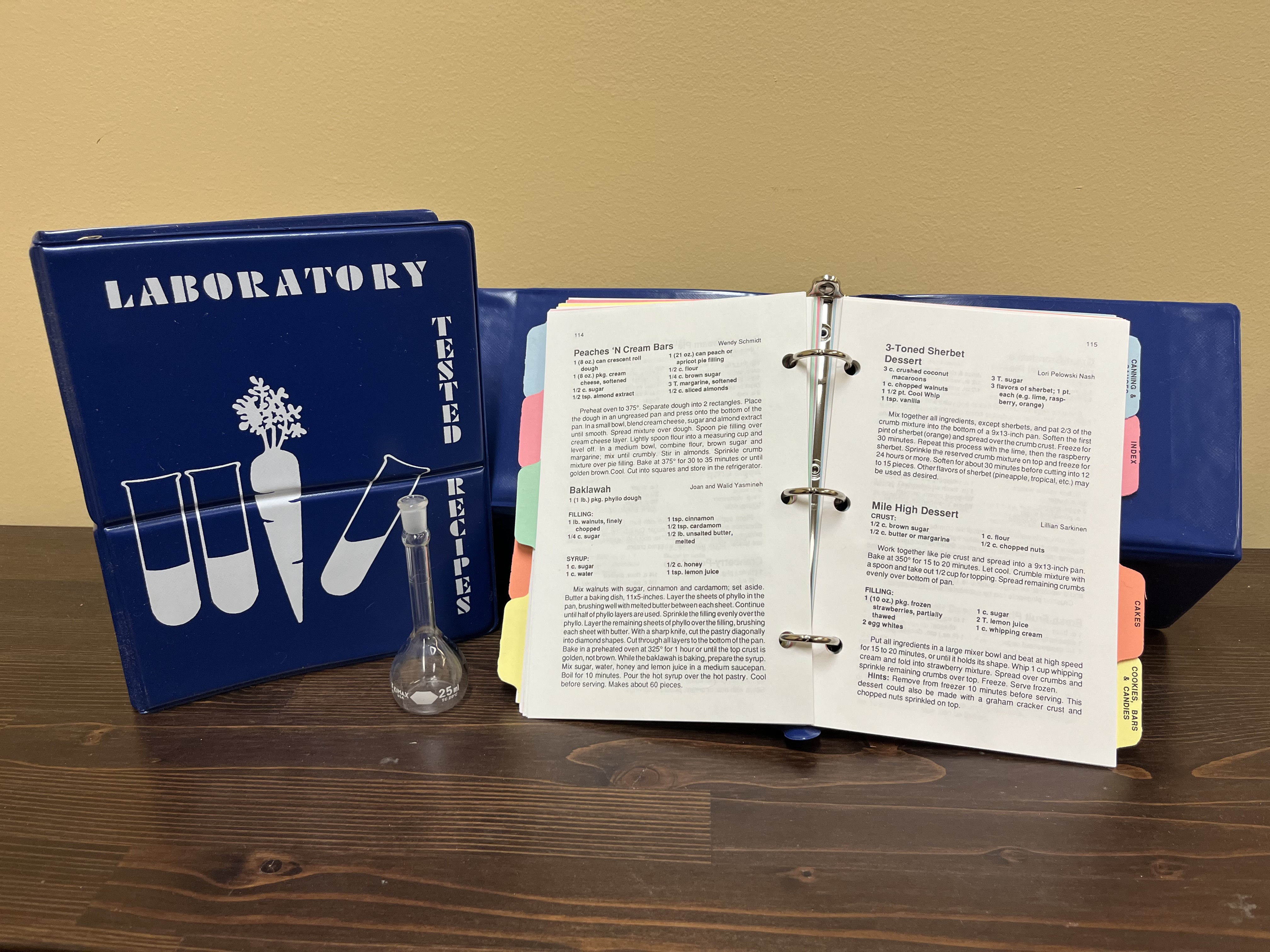
- The 1990s provided the program with several new scholarships due to the donations of our generous alumni. Yvonne Chenoweth Cooke, MT Class of 1937, established an endowed scholarship fund established in 1991. In 1992, the Betty Rae Kramer McConnell Scholarship Fund was established, and in 1994, the Phyllis Lund Kelsch Scholarship fund was established to help students during one of the most financially difficult times. In 1999, MT faculty Karen Lofsness established the Hematography Scholarship using a portion of the funds from the sale of her CD-ROM Hematography II.
- In 1991, a survey went out to alumni to get their thoughts on whether the program name should be changed to “Clinical Laboratory Science”.
- In 1992, MT faculty Karen Lofness received a Health Sciences Instructional Computing Award to develop a computer program for teaching the blood smear differential counting procedure. These funds lead to the development of Hematography, a nationally recognized program to assist students in recognizing blood cell morphology.
- 1993 Medical Technology Alumni produced a cookbook to raise funds to support the education of the Medical Technology students. It should be noted that the 1930s University of Minnesota Bulletin did state that the “ability to cook and sew is an excellent asset for would be technicians” when describing the characteristics of a well-trained medical laboratory technician. On May 4, 1994, this cookbook was highlighted in a column in the St. Paul Pioneer Press.
- In 1997, the University of Minnesota converted from the quarter system to a semester system, which resulted in a curriculum revision.
- Hematography Scholarship established by Karen Lofness (1999) portion of the funds are from the CD-ROM Hematology II
2000's

- In 2000, the Yvonne Chenoweth Cooke (MT 1937) Endowed Professorship was established
- In 2002, the Mildred King Rohwer Professorship was converted to the Rohwer Chair following a generous donation from Carl Rohwer.
- In 2007, the Medical Technology Program was moved out of the Medical School and into the newly created Center for Allied Health Programs. The Medical Technology Program became the Clinical Laboratory Sciences Program and expanded to also having a presence on the newly created University of Minnesota, Rochester campus.
- Along with the new name, the Clinical Laboratory Sciences Program starts a new way of teaching, using web-enhanced education.
- The Twin Cities student laboratory was relocated to the new Molecular and Cellular Biology building, allowing the program to expand its capacity to 48 students, and interact with the Rochester student laboratory simultaneously.
- First Clinical Laboratory Sciences class graduates in 2009.
2010's
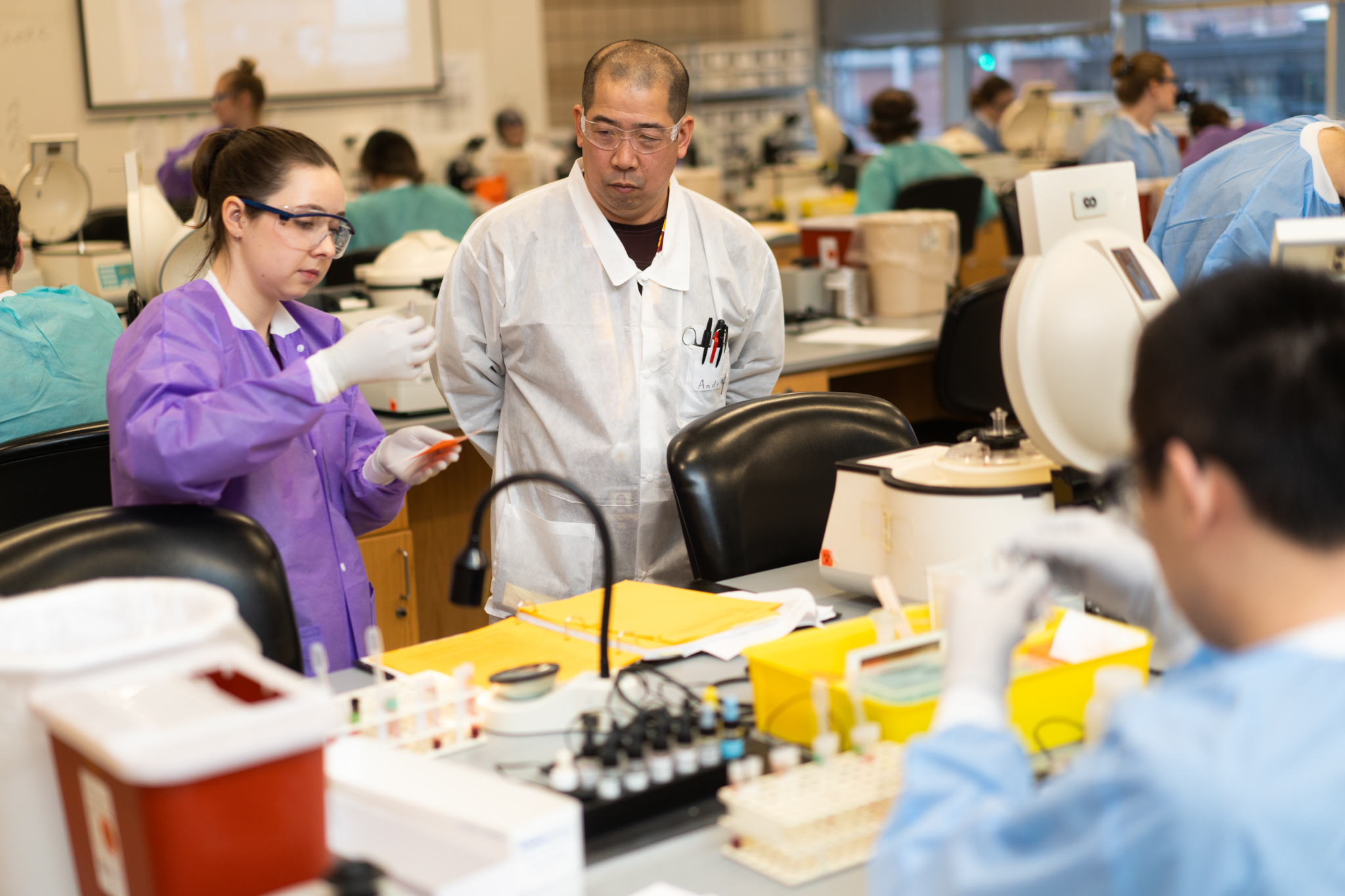
- In 2013, the CLS Program was chosen to participate in the University of Minnesota’s Writing-Enriched Curriculum Program. As part of this program, the program incorporates writing in the majority of their classes to help students learn and practice the type of writing they will need in the profession.
- In 2014, the Program once again changed its name from Clinical Laboratory Sciences to Medical Laboratory Sciences to correspond to a change in the name of the credential that graduates will be achieving.
- With the change in the program name comes a change in educational model to a hybrid, flipped classroom model. In this model, students listen to the recorded lectures before coming to class. When they are in the classroom, they do active-learning activities and group work to help them apply the knowledge that they learned about in the recorded lecture.
- In an effort to address workforce issues across the State of Minnesota, the MLS Program initiates an MLS certificate program, which will allow students from St. Cloud State University, Minnesota State Mankato, and the University of Wisconsin, River Falls to do the final year of their degree at the University of Minnesota. These students receive the MLS Certificate from the University of Minnesota, but their BS degree from their home institution.
- The high percentage of student coming to the program after having already completed their baccalaureate degree results in the MLS Program developing a new Professional Master’s Degree in Medical Laboratory Sciences (MMLS degree), which provides the education needed for students to sit for the certification exam, and also additional experience in management, molecular testing, and research.
2020 - present
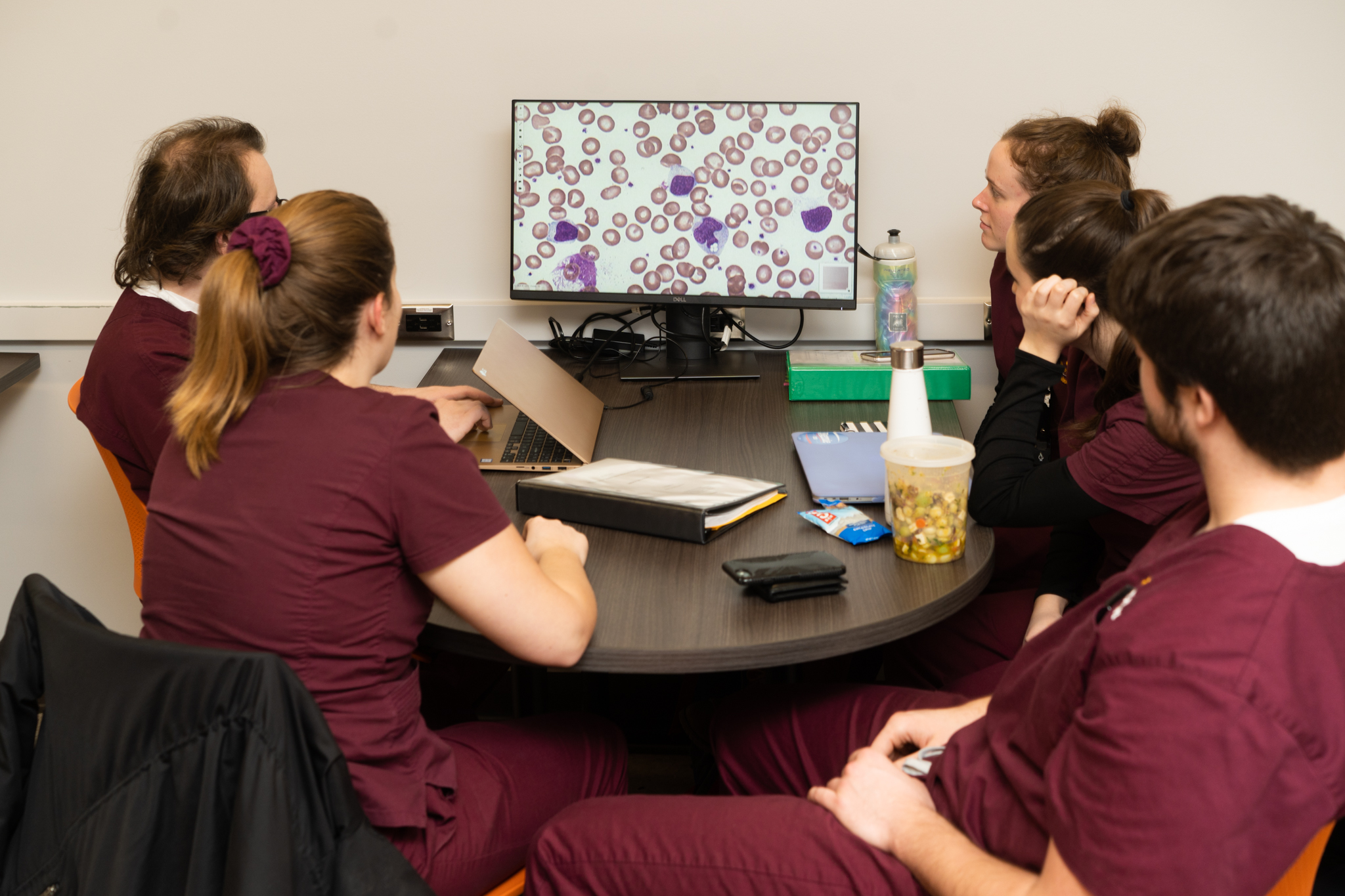
- 2020 was a unique year for the entire world, as the COVID pandemic spread. This also helped show the country the important role the medical laboratory plays in heath care.
- In March, 2020, all of the MLS Programs courses suddenly switched to virtual courses (including student laboratory courses). The flipped classroom model used by the MLS Program made the courses much easier to convert to totally only courses, as all of the lectures were already recorded and available to students.
- Faculty were not allowed on campus during the early days of the pandemic, so they had to be creative in how they converted laboratory exercises to a virtual format, as is shown by this video created by faculty to show student how testing for fecal occult blood testing is performed.
Due to the severe shortages and increased need in the medical laboratory workforce, the Medical Laboratory Sciences Program got special permission to bring students back to campus to complete necessary laboratory exercises that could not be performed online. MLS faculty pitched in by sewing masks for all of the MLS students. Refer back to the 1930s University of Minnesota Bulletin that stated the “ability to cook and sew is an excellent asset for would-be technicians” when describing the characteristics of a well-trained medical laboratory technician. It proved to be true once again!

- Hospital laboratories were not allowing students in for clinical rotations during the pandemic, so faculty developed a simulated clinical experience so students could be eligible to take the certification exam, and join the workforce without delaying their degree.
- In an effort to help other MLS and MLT programs that were forced to suddenly teach their student laboratory exercises online, the MLS program offered free access to the digital microscope slide database developed by Dr. Stephen Wiesner.
- The MLS Program receives a $3.2 million HRSA grant for scholarships for students from medically underserved areas, first generation college students, and other students in need.
At the 2022 Alumni Banquet, the MLS Program kicks off a year-long celebration of the 100th anniversary of the program. Three past/present program directors are in attendance.
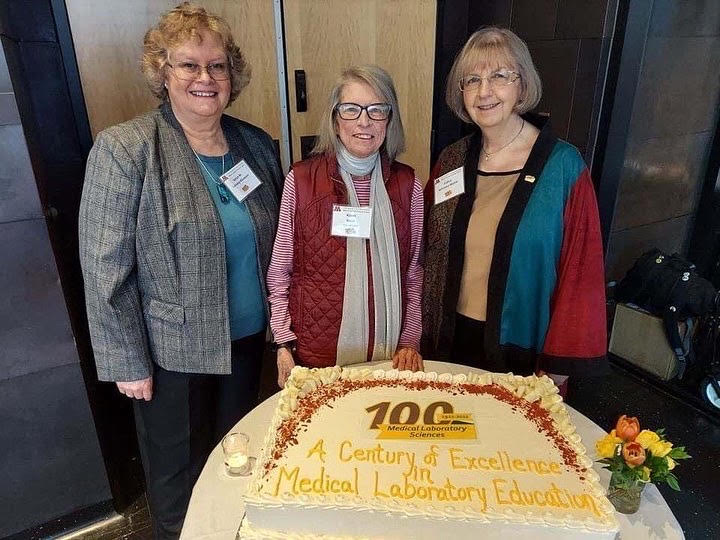
Pictured: Janice Conway-Klaassen, Karen Karni, Donna Spannaus-Martin - The Center for Allied Health Programs, including the Medical Laboratory Sciences Program move to the College of Pharmacy in July, 2022
- The MLS Program begins a totally online Master of Science in Biomedical Laboratory Science in the Fall, 2022
